Blog Archives
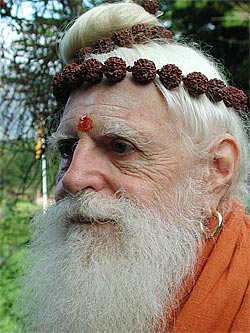
“Sri Ramakrishna, the great Indian saint, compared the mind’s turning inward, seeking to connect itself to God, with the image of a little boy holding on to a rope tied to a post. The little boy swings on the rope and it winds him around and around the post. Then he swings the other way, still holding on to the rope, and the rope wraps him around the post again. The little boy represents man simply having fun and enjoying the experiences of life. He is perfectly safe as long as he holds on to the rope and the rope is connected to the post, for the post is God, and That doesn’t move. The little boy we would call mind. The rope connecting mind to God is the soul, the indomitable will. And so, Shri Ramakrishna went on to say, if man turns his mind inward and keeps his mind looking within, he will see the reality of Spirit and the transient nature of all of the mind’s activity. He may live in and enjoy the activity of the mind and never be hurt or harmed so long as he holds on to that rope, maintains his inward vision constantly and holds himself connected to the permanence of his own Being.” –Gurudeva
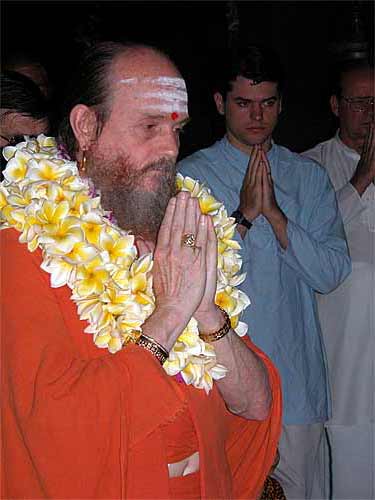
Our new phase began with a beautiful homa this morning.
 |
 |
 |
 |
 |
 |
||||
Click for most recent TAKA page with an Iraivan Temple progress update. |
||||
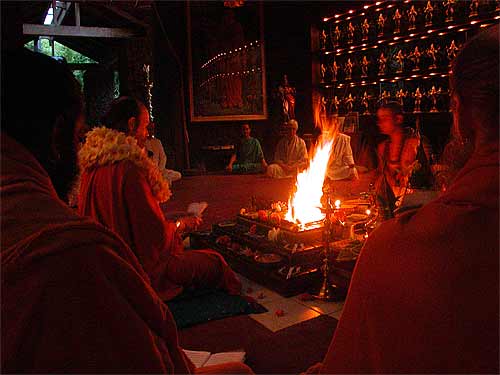
The Lombodara Kulam’s phasely report shared news of our guests today, the successful work the monks did on Iraivan day and fund-raising news.

Meditating during the homa is always a light-filled inner experience.
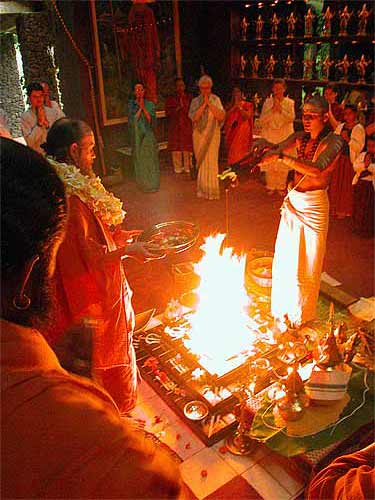
Purna-ahuti
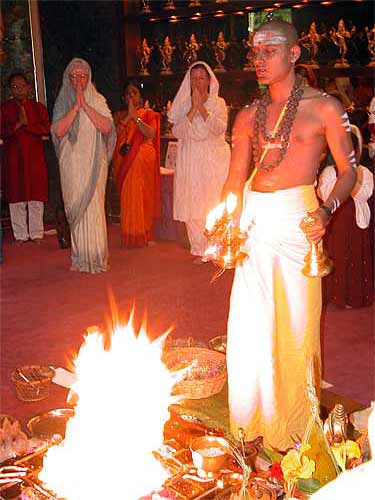
Final arati

Listening to Bodhinatha’s talk…
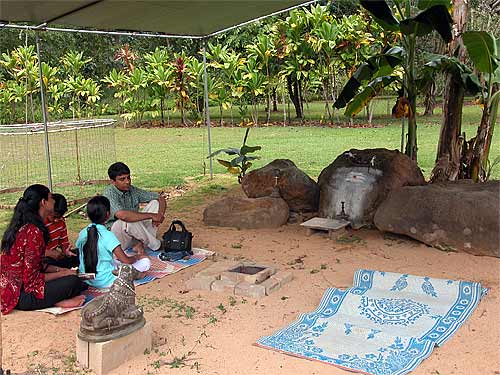
Mohan and Geetha from Cupertuno, California, were here on their first visit to Kauai Aadheenam with their children Vikram and Amrita.
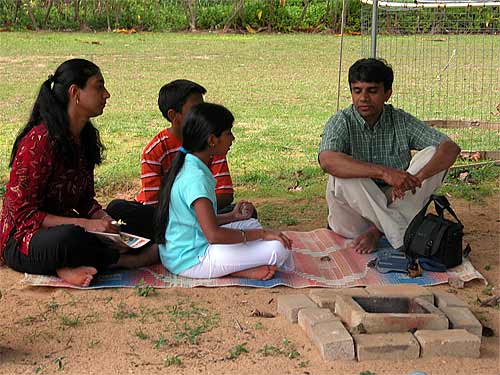
Here, they are at the Swayambhu Lingam site singing thevarams to Lord Siva. Amrita is a really good singer.
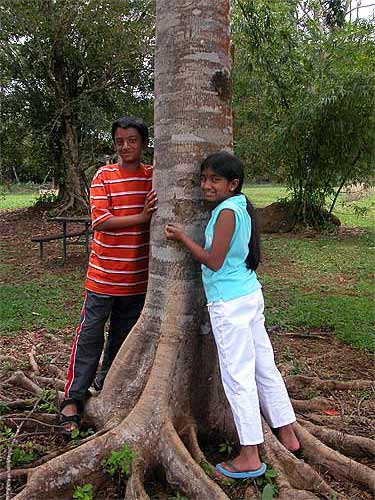
Vikram and Amrita hug a rudraksha tree. They said they really like Kauai Aadheenam and want to come back again.
 The Remarkable Vision |
Iraivan Temple Progress Update |
Join this historic undertaking. Please contribute generously. Sponsor a stone today! |
| New Beautiful 2004 Calendar Now Available. Seeing out fast! | ||
Other TAKA pages with recent Iraivan images.
 |
||
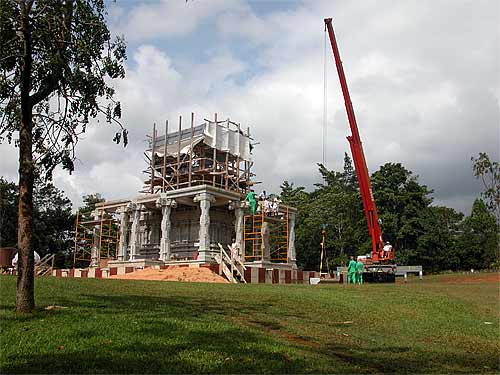
On Iraivan day, April 18th in the morning five uttaram, roof beams, were raised up to Iraivan.
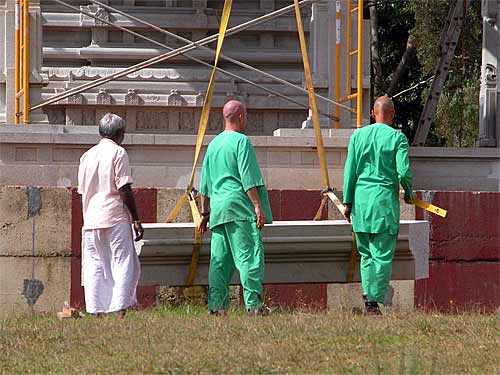
The ground crew handles the rigging. It consists of two super strong straps around either end of the beam.
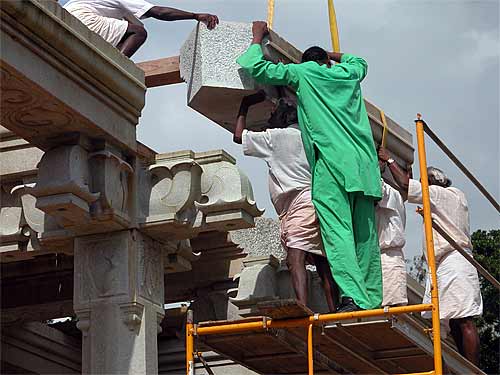
Because of the very careful measurements and preparations that Sthapati had made on the ground level, the beams were a perfect fit.
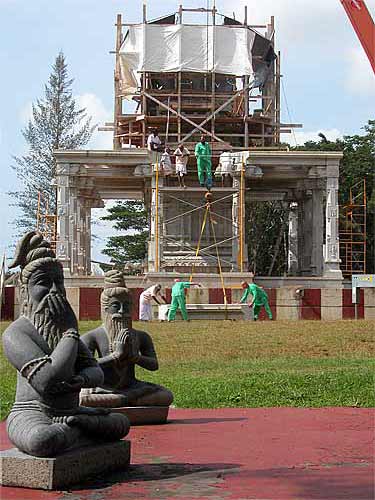
A view from Dakshinamurthi’s vantage point looking at the north end of the temple.

In India we are told it would take an entire day to put up a single beam. Our team was clocking in at about 20-25 minutes per beam.

We were blessed with beautiful weather.
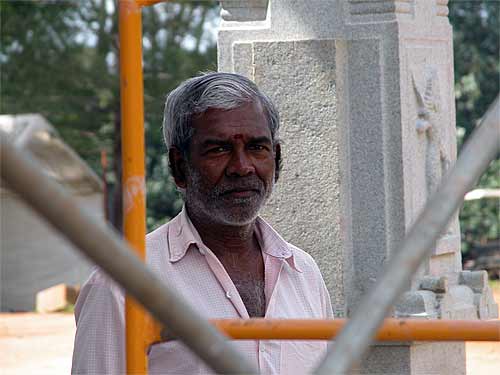
Silpi Sankaran Asari on the ground team.
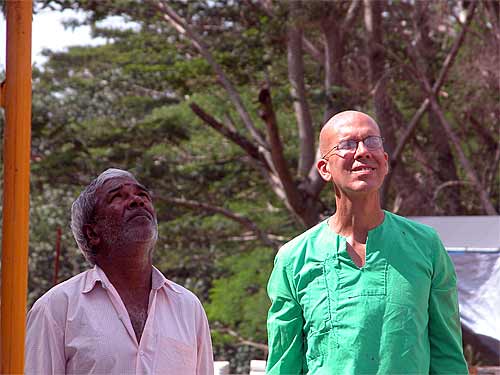
Sadhaka Adinatha and Sankaran watch as the beam goes up.
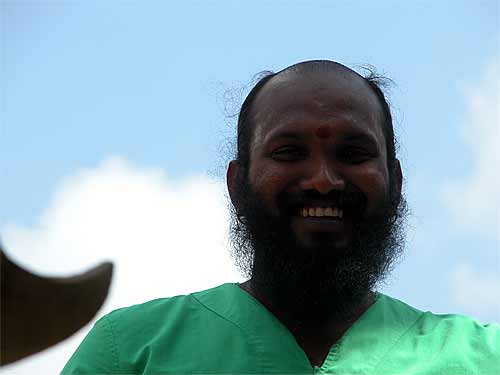
Sannyasin Yoginathaswami supervising from aloft.
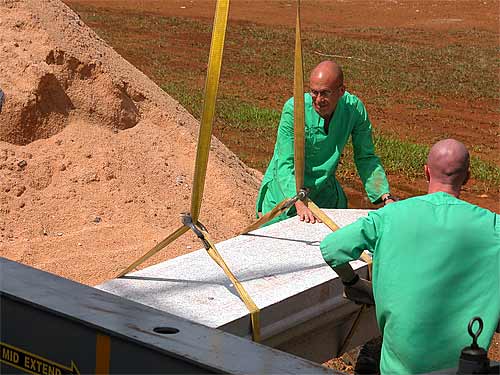
Next!
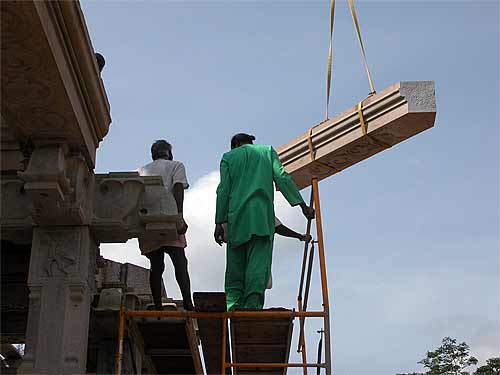
Five beams went up and four potagai were flipped over, all during this one morning. It would take two days to flip the potagai alone with the forklift.
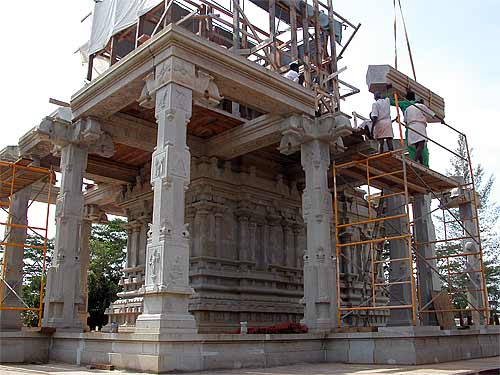
We have nearly completed the entire perimeter around the sanctum.
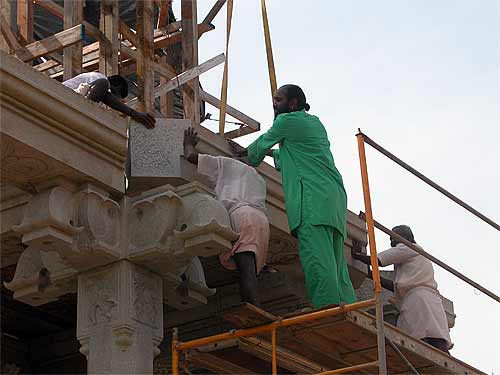
A perfect fit and a perfectly smooth day. Sthapati just could not believe it. “Amazing, we are done already… next time we need to have more work ready for him when he comes with the crane!”
 |
Himalayan Academy Travel Study Programs |
Images from the Recent 2004 Indian OdysseyJanuary 19, 2004 – February 5, 2004 Bangalore, Madurai, Tanjavur, Chennai and |
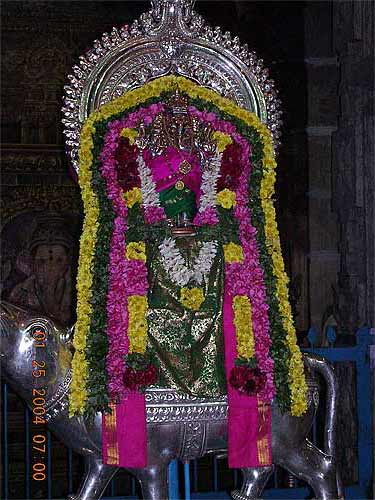
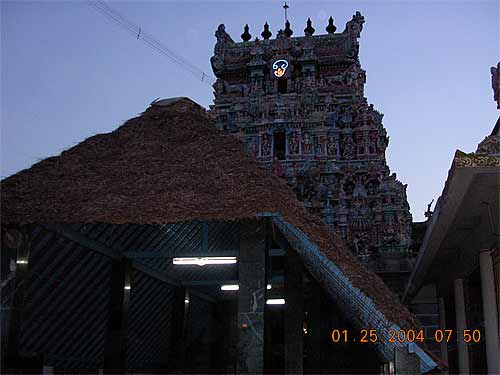
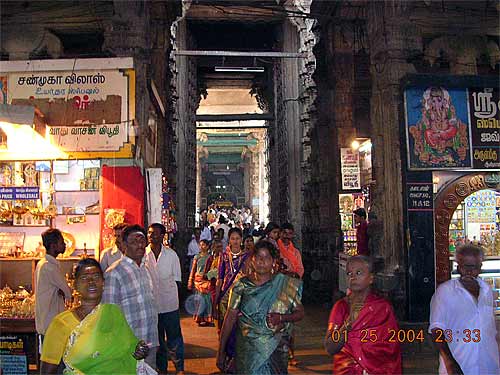
No Audio Today
|
Take this opportunity for an adventure. Close your eyes and click to get a message picked at random from the vast audio archives of our Satgurus’ discourses |
And click here for an Index to All Past CyberTalks. Study Gurudeva’s teachings. Visit the Master Course site! |
| FULL INDEX OF 650+ CYBERTALKS
 |
|
Study Gurudeva’s teachings.
|
transcription begins
Date: February_24_2004
Title: I Want to See God
Category: The Ultimate Goals of Life
Duration: 17 min., 47 seconds
Date Given: February 15, 2004
Given by: Bodhinatha
‘Hinduism Today’ also provides Hindu leaders an opportunity to express their opinion on what they consider contemporary issues, through its ‘Publisher’s Desk’, ‘Minister’s Message’ and ‘My Turn’ columns.
In a recent ‘Publisher’s Desk’, I wrote on the topic “I want to see God – Some pertinent suggestions to sincere seekers on where and how to look for Divinity.”
The reason I chose this topic was to emphasize that one of the greatnesses of Hinduism is that it is experientially-oriented rather than belief-oriented. In other words, the goal is to not simply believe in God, but rather to eventually experience God.
The idea for this article came from a visit to the home of wealthy Hindu family of doctors in the suburbs of Chicago, Illinois. The son who had been raised in the US asked a question, “Aren’t all religions pretty much the same? Does it really make a difference which religion you practice?” I answered the question in a simple way at the time and kept thinking about it afterwards and developed an analogy that goes like this. Of course, it is a medical analogy. The question is, “Aren’t all medical clinics pretty much the same?”
Only if you have a simple illness. If you have a complex problem and need the more sophisticated medical equipment and specialist, then they are definitely not. This is based upon what happened to one of our silpis. He ended up in Honolulu to check out a heart pain. It was amazing what happened.
For example, someone is suffering from chest pain and goes to his family doctor who lives nearby. The doctor is not sure what the problem is and suggests he go to the hospital to have certain tests taken. He does so and the hospital, after taking the tests is still not sure of the problem and refers him to a cardiologist living in a large city nearby, for even more tests. Clearly, all clinics are not the same.
Religion is similar to this. If all you want is to live a virtuous life, religions are all very similar at that basic level of practice. But if you have an interest in personally experiencing God, then only a few religions have within them the practices that lead to that experience.
A good example of this fact has been occurring in Catholic monasteries for decades. Some of the monks in these monasteries have the desire to personally experience God. What do they do to pursue this? They turn to Hindu scriptures such as the Patanjali Yoga aphorisms to provide them proper guidelines for deep meditation, as there are no teachings regarding this in Christianity. This is a common fact. We have met many Christian monks over the years, who are deep in the study of Patanjali.
Returning to the ‘Publisher’s Desk’ I wrote. It begins with a classic story about Swami Vivekananda when he was still a college student in Calcutta. He went around to the religious leaders in the Calcutta area and asked them all if they had seen God. None of them gave a satisfactory answer to this question until he met Sri Ramakrishna. The answer that Sri Ramakrishna gave was, “Yes. I see Him as clearly as one sees an apple in the palm of the hand. Nay, even more intently. And not only this, you can also see Him.”
Pretty good answer! This answer deeply impressed the young Vivekananda who soon after accepted Sri Ramakrishna as his Guru.
Many individuals are inspired by the thought of seeing God. It seems very distant and unattainable. This is because we think of jumping somehow from 0% consciousness of God’s presence to 100% awareness of God presence. This is where our concept of enlightenment may be a barrier. That enlightenment is an instantaneous event, coming out of nowhere totally transforming us like a flash of lightening. It is more helpful to think of enlightenment as a gradual process, which involves increasing our control over our instinctive nature, controlling our thoughts better and experiencing more and more of our innate divinity.
To experience God, do we sit on a mountain top, go into a cave or simply close our eyes? Where do we go to see God?
Perhaps the easiest place to start is to see God in great religious teachers. We feel a spiritual aura about them that is different. We see a light in their eyes that we do not see in others. The sound of their words encourages us to live a more spiritual life.
I had an interesting experience in this regard. One of the things you have to be careful of in India is if you think something, it is liable to happen. India is very unusual in that way. For example, we were in Madurai at this nice hotel, the Taj Garden Retreat Hotel. The monks are used to eating fruit and yogurt for breakfast. So, I was having my fruit and yogurt for breakfast and thinking about all the great stuff like big dosai and all the other things. It was the last day and I thought, “Well, I’ll splurge. This morning, I’ll have a big dosai.Why not? It is just the last day, break my traditional meal.”
So I thought that and then one of the ladies brings over a dosai and says, “Here is a dosai for you.” I say, “Thank you!” and then another lady comes over and doesn’t realize that I had one and says, “Would you like a dosai?”
That happened no other morning. It is not like, every morning someone would bring me food. That one morning I had the thought and there before I know it, I have dosai.
The example here of this talk was given one night. We go and see God and religious teachers. We went to this temple, Arupadai Veedu temple the next day in Chennai and if you read the description, we said we managed to do the Arupadai Veedu three times in one morning. All six temples are right near the beach, all the shrines are finished. We went around all six shrines three times, most of the Innersearchers carrying milk in a pot. It is a traditional Thai Pusam activity.
As they were going around, the monks were attending an Abhishekam somewhere else. Other things were happening and other activities-it was a multi activity morning. I forget exactly where we were and this man came up and just went on and on, “Oh, I see God in you. You are so radiant, I see God in you!”
So you have to be very careful what you think in India. It is liable to happen.
Another way to see God, which is a little more difficult but still easy to do, is look deeply into the eyes of another person.
Of course, the challenge is to get past the personality because maybe we don’t like the person, or are mad at the person because they did this and they did that. We see the personality, we see the part of them that we are mad at. So we don’t like them, we don’t go in deeply enough. That is the challenge, to get past the personality and see the soul in everyone. Regardless if we like them or not, we should be able to see the soul in them.
We talked about seeing God in the temple through the image. On the Innersearch, some of the Innersearchers had some very nice experiences at the temple where the Deity moved, smiled and came to life. One of the nicest ones was at Pillaiyarpati, the big Ganesha with two arms, which is near Madurai more precisely near Kundrakudi and Karaikkudi which is where all the silipis come from. It is slightly south of what is called Chettinad, which is the Chettiar stronghold in the south. It is a nicely run temple, it has been there for 1500 years, doing its daily pujas. That is quite a long time.
The Ganesha is just huge and you have a nice view of it. The puja was particularly nice. Everyone was up close and they also had about 10 or 15 priests. There is a priest training school, a padasala there. So the older members get to chant during the puja and help at part of the puja as their training. There was more priests than usual. They would chant Sri Rudram and half the group would chant one line and the other half would chant the next line. The first half would hold the last syllable for a little bit so there would be an overlap of that last syllable of that one line with the first couple of words of the next line. It went back and forth like that. Really nice and very precise chanting. A long Abhishekam with lots of substances poured. It is a huge Ganesha. So to cover it with milk or yogurt or vibhuti, it takes a lot. They were going on and one of the Innerseachers had a really nice experience there, felt Ganesha’s presence more than they had their whole life. It fulfills the idea of experiencing God through the temple quite nicely.
Next one of course, is meditation.
A key to deepening our experience of God is the regular practices of religious disciplines. It is fair to say that no other religion contains such a vast range of spiritual practices from such fundamental virtues, such as non-injury and purity, to temple worship to advanced yoga practices and meditation.
I was recently asked a question by a New York radio show on Hinduism as well as by Hindu pilgrims to our Kauai Monastery. The question is, ” We are all so busy with the demands of modern life. There is little time left for spiritual practices. What do you consider to be the most important practices to be followed?”
That is a good question, so I thought about it. For the radio show, I thought about it ahead of time and this was my answer. The answer I gave was to do two things. Establish a shrine in the home and worship there every morning. Secondly, go to the temple once a week.
For the morning worship, the routine to follow depends on the religious background of the family. But typical practices include a simple arati or longer puja, singing devotional songs, repeating a mantra, reading scripture and meditation.
Those are the two important things and it is surprising how many people don’t do a morning worship. Even though they are very sincere, wanting to advance spiritually. They haven’t committed to doing a worship every morning. Of course, that is the most important sadhana. It can be compared to physical exercise. To benefit from physical exercise you supposed to exercise a half an hour a day, for at least five days a week. Elevate the heart by fast walking, bicycling, swimming. Five times a week for half an hour. If you do it once a week and then twice a week and then you skip it and so forth, you don’t get the benefits. That is something everyone understands for the physical body.
For spiritual, it is harder to see but it works the same way. If we do our morning disciplines which we are supposed to do everyday except for weekends, if every work day or school day we do our morning devotional then our spiritual life does move forward, though we may not see it but it does move forward to benefit. But if we are erratic then we probably don’t make much progress.
That is one of the nice things Gurudeva stressed so strongly, “Create a nice habit.” A lot of the older members are doing that. A half an hour vigil looks so short compared to what we are used to do. In the monastery it is easy, everyone gets up. If you don’t get up you don’t get to do your normal kulam work. So, everyone is really motivated in the monastery. Everyone likes to do their work!
Anyway, it is nice to be back. We had a great trip. Ninety people as you can imagine is a large group, three buses worth in India. Every time we got on a bus it would take a half and hour, to get everybody into the bus.
That was a major accomplishment, moving through India. Fortunately the program was nicely planned and beautifully executed. Because of that, it was quite successful. We had lots of help, both before hand and during. For example Nellaiappan helped set things up. Sheela and Narayanan Venkatakrishnan were very helpful including their family, helped set things up. So between them and others, special activities happened quite nicely. Coordinating a big Abhishekam takes hours of someone’s work to get all the materials together, get them to the temple and so forth. The biggest one we had was, of course, at Brihadeeshvara. The size of that Lingam-huge! You can imagine how much milk and everything was needed, where was it all acquired. They were up on a scaffold much like a construction project than a temple. Priests were up on a scaffold for a long time. So that was quite beautiful. Then when they opened it, the decoration was so beautiful, the flowers covered the whole base and half of the Lingam, beautiful three colors of flowers. They had alternating rows of green, red and yellow flowers on this huge Lingam base, half way around and a few other garlands that were different colors going the other way, very beautiful.
That was also a nice experience because everyone could see the Lingam. It is so big and the opening of the temple is so big. Whereas, at some of the temples unfortunately you could only spend a few seconds in front of the Deity, and can’t really stay. Not enough room for ninety people to get close.
The temples where we had longer experiences with the Deity were definitely superior to the ones where we were rushing by in a few seconds.
Okay, nice to be back!
transcription ends
|
MORE UPLIFTING THINGS |
Color Trilogy Complete! We are happy to announce that the new edition of the enormously popular Dancing with Siva is now available in hard back with all new color artwork. It’s truly an amazing and beautiful work, with more art than any of the collection. This completes the fulfillment of the vision that Gurudeva had of his Master Course Trilogy being produced in full color. In addition, Bodhinatha is taking pro-active steps to bring Gurudeva’s teachings out in a new forms that can be broadly disseminated in the mass mind. With this in mind we, are also pleased to announce that the Dancing with Siva pocketbook is also available. Keep the three-pound book in your shrine room, and take the little one with you on the airplane or subway! How little? It’s just 3″ by 4.5″ — truly pocket-sized, and just over half an inch thick. Yet it is a full 375 pages, containing ALL of the 155 sutras. Available now at our online store. The complete Trilogy is being offered at a discount. |
|

|
View the fabulous full-color PDF’s of the latest edition of Island Temple Magazine, and order copies if you don’t have one. | |
|
1. SIGN OUR GUESTBOOK and receive a FREE GIFT |
||
| 2. Newest Book: DANCING WITH SIVA — Pocketbook | ||
|
3. Visiting KAUAI’S HINDU MONASTERY |
||
|
4. Contribute to THANK YOU, GURUDEVA FUND |
||
From Our Gurus' Teachings
Archives are now available through 2001. Light colored days have no posts. 1998-2001 coming later.
